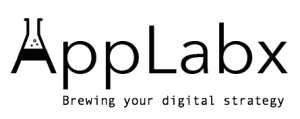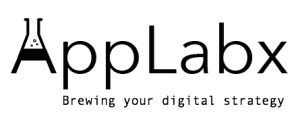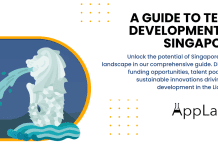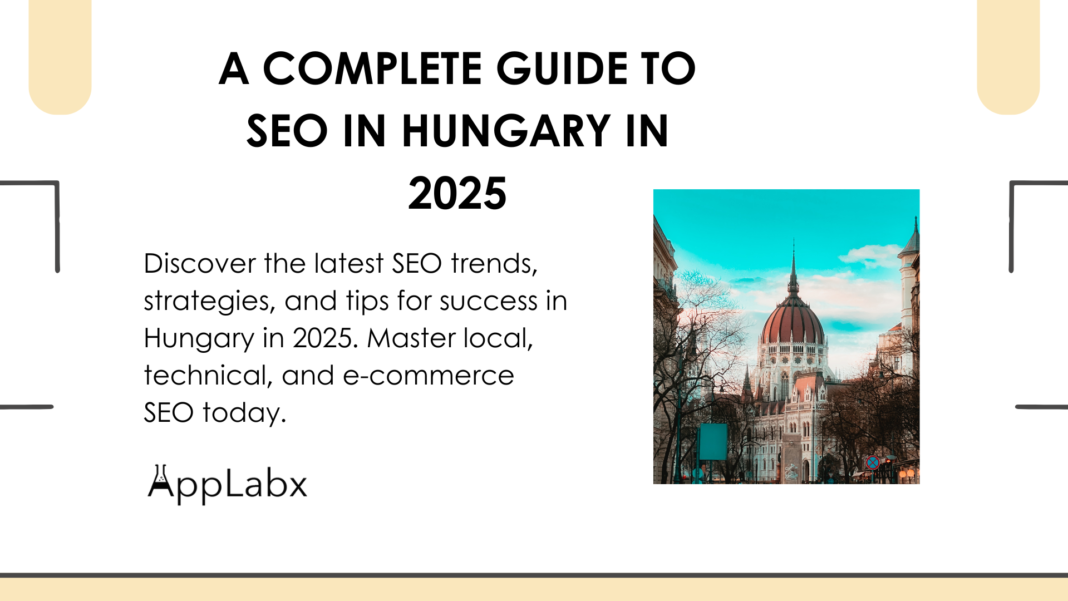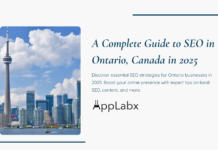Key Takeaways
- Focus on user intent and experience by creating high-quality, localized content for Hungarian audiences.
- Embrace AI, machine learning, and voice search optimization to stay competitive in the evolving SEO landscape.
- Prioritize technical SEO, including mobile optimization and Core Web Vitals, to enhance website performance and rankings.
In today’s digital-first world, search engine optimization (SEO) is no longer optional—it’s a necessity.
Businesses in Hungary are increasingly recognizing the power of SEO to drive organic traffic, boost brand visibility, and increase revenue.
As we step into 2025, SEO in Hungary has evolved significantly due to Google’s algorithm updates, AI-driven search enhancements, and changing user behaviors.
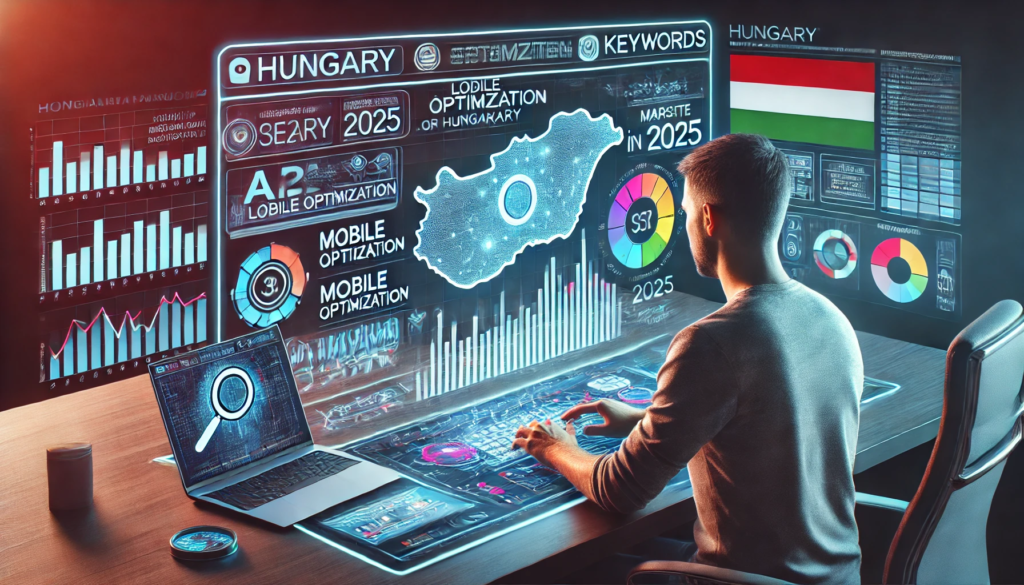
With Hungary’s internet penetration exceeding 85% and mobile searches dominating the digital landscape, it’s clear that businesses must optimize their online presence to stay ahead.
Whether you run a local Hungarian business, an e-commerce store, or a multinational brand targeting the Hungarian market, mastering SEO will be the key to your success.
The State of SEO in Hungary: A Growing Digital Landscape
Hungary’s digital economy is thriving, with a rapidly growing number of businesses investing in online marketing. Here are a few key insights into Hungary’s digital landscape in 2025:
- Google remains the dominant search engine, with over 95% of searches in Hungary conducted on Google.hu.
- Mobile-first indexing is now the standard, meaning websites optimized for mobile devices perform significantly better in search rankings.
- Local SEO is more important than ever, as Hungarian users rely heavily on Google Maps and “near me” searches for local services.
- Content quality and relevance drive rankings, as Google’s AI-powered search algorithms prioritize helpful, well-structured content.
For businesses looking to increase their online visibility in Hungary, understanding these trends and adapting SEO strategies accordingly is crucial.
Key Challenges and Opportunities in Hungarian SEO
While SEO presents vast opportunities, businesses also face several challenges when optimizing for Hungarian search engines:
Challenges
- Hungarian Language Complexity: The Hungarian language is unique and differs significantly from English, making keyword research and content optimization more complex.
- Strong Local Competition: With many businesses investing in SEO, ranking on the first page of Google has become more competitive.
- Algorithm Updates: Google’s frequent algorithm changes require businesses to constantly update their SEO strategies.
Opportunities
- Voice Search & AI: More Hungarian users are adopting voice search, creating opportunities to optimize for conversational keywords.
- E-commerce Growth: Hungary’s e-commerce sector is booming, making SEO crucial for online stores looking to attract more customers.
- Localized SEO Strategies: Businesses that focus on local SEO, high-quality content, and user experience can outperform competitors.
What You Will Learn in This Guide
This comprehensive guide will provide you with everything you need to know about SEO in Hungary in 2025. Whether you’re a beginner or an experienced marketer, this guide will help you:
Understand the latest SEO trends shaping the Hungarian market
Conduct effective keyword research for Hungarian users
Optimize on-page and off-page SEO for better rankings
Implement local SEO strategies to attract nearby customers
Improve technical SEO for faster, more user-friendly websites
Stay compliant with Google updates and GDPR regulations
By the end of this guide, you’ll have actionable insights and proven SEO strategies that will help your business rank higher in Hungary’s competitive digital landscape. Let’s dive in.
But, before we venture further, we like to share who we are and what we do.
About AppLabx
From developing a solid marketing plan to creating compelling content, optimizing for search engines, leveraging social media, and utilizing paid advertising, AppLabx offers a comprehensive suite of digital marketing services designed to drive growth and profitability for your business.
AppLabx is well known for helping companies and startups use SEO to drive web traffic to their websites and web apps.
At AppLabx, we understand that no two businesses are alike. That’s why we take a personalized approach to every project, working closely with our clients to understand their unique needs and goals, and developing customized strategies to help them achieve success.
If you need a digital consultation, then send in an inquiry here.
AppLabx SEO Agency: Your Trusted Partner for SEO Success in Hungary in 2025
In the ever-evolving world of SEO, staying ahead of the competition requires more than just a basic understanding of search engine algorithms. It demands innovative strategies, local expertise, and a proven track record of success. That’s where AppLabx SEO Agency steps in as Hungary’s top SEO agency for 2025.
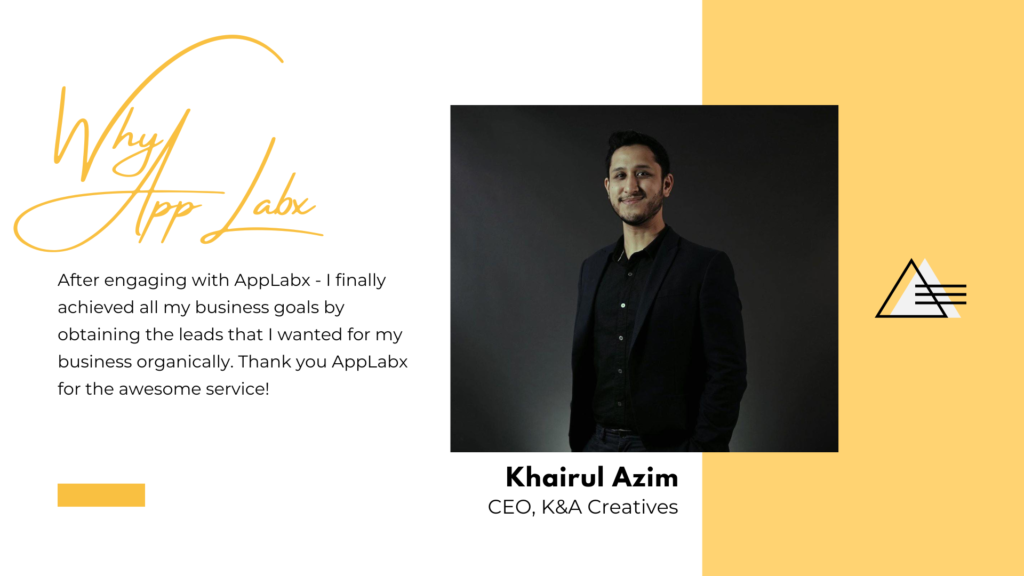
With a deep understanding of the Hungarian digital landscape and global SEO best practices, we specialize in creating customized, data-driven strategies that deliver real results. Whether you’re looking to boost local visibility in Budapest or enhance your national or global SEO reach, AppLabx SEO Agency is equipped to elevate your brand.
Why AppLabx SEO Agency Stands Out in Hungary for 2025
- Expertise in Hungarian Market Dynamics
AppLabx has an in-depth understanding of the Hungarian market, including language, consumer behavior, and local search preferences. Our SEO strategies are designed specifically for Hungarian businesses, ensuring that your brand ranks higher on search engines like Google, attracting more targeted traffic. - AI-Powered SEO Solutions
As SEO moves into the future, AI-driven algorithms and machine learning are transforming the way we approach search engine optimization. At AppLabx, we leverage cutting-edge AI tools to deliver precise, scalable SEO strategies that keep you ahead of the curve in Hungary’s competitive market. - Comprehensive SEO Services
From on-page optimization, technical SEO, and local SEO to content marketing, link building, and e-commerce SEO, AppLabx offers a full suite of SEO services that are tailored to meet your specific needs. Our holistic approach ensures every aspect of your website is optimized for maximum performance. - Proven Track Record of Success
We’ve helped businesses of all sizes achieve sustainable growth through strategic SEO. Our clients enjoy increased organic traffic, better search engine rankings, and improved conversion rates, positioning them as industry leaders in Hungary. - Transparent Reporting & Continuous Improvement
At AppLabx, we believe in transparency and measurable results. We provide regular, in-depth reports on your SEO performance, so you always know how your website is doing. Additionally, we constantly refine our strategies based on real-time data, ensuring continuous improvement. - Future-Focused SEO Strategies
SEO in Hungary in 2025 will require businesses to adapt to new trends, including voice search, AI-driven content, and video SEO. AppLabx stays on top of these trends and implements strategies that future-proof your SEO efforts, ensuring long-term success.
Our SEO Services for Hungarian Businesses in 2025
- Local SEO Optimization
Rank higher in Hungary’s local search results with customized SEO strategies for Hungarian cities and regions. Optimize for Google My Business and local map packs to drive more foot traffic and local leads. - E-commerce SEO
Unlock the potential of your online store with AppLabx’s e-commerce SEO services. Improve product visibility, optimize for Hungarian search terms, and convert visitors into customers through tailored strategies. - Content Creation & Optimization
Whether it’s blog posts, landing pages, or product descriptions, we create content that ranks. Our content strategy is designed to meet the unique needs of Hungarian users, ensuring that your content is both relevant and valuable. - Mobile Optimization & Speed Enhancement
As mobile-first indexing becomes even more critical, we ensure your website is fully optimized for mobile devices. We also improve site speed to meet Core Web Vitals and enhance the user experience. - Technical SEO
From website audits and structured data implementation to improving crawlability, our technical SEO team ensures that your website performs at its best, making it easier for search engines to index and rank. - Link Building & Outreach
Build a strong backlink profile with our proven link-building strategies. We focus on acquiring high-quality, relevant backlinks from trusted Hungarian and international websites to boost your domain authority.
Partner with AppLabx for SEO Excellence in Hungary
In 2025, standing out in Hungary’s digital space requires a strong, data-driven SEO strategy. At AppLabx SEO Agency, we combine local knowledge, innovative tools, and results-driven strategies to help you achieve SEO success in Hungary. From the moment you partner with us, you can expect transparency, accountability, and a strategic roadmap that takes your brand to new heights.
Don’t let your competition outrank you. Contact AppLabx SEO Agency today and see how we can help you dominate Hungary’s search results in 2025
A Complete Guide to SEO in Hungary in 2025
- Understanding the Hungarian Digital Landscape
- Key SEO Trends in Hungary for 2025
- Keyword Research for the Hungarian Market
- On-Page SEO Strategies for Hungary
- Off-Page SEO and Link Building in Hungary
- Local SEO in Hungary
- Technical SEO Considerations in Hungary
- SEO for E-commerce in Hungary
- SEO Compliance and Algorithm Updates in Hungary
- Measuring SEO Success in Hungary
- Future of SEO in Hungary Beyond 2025
1. Understanding the Hungarian Digital Landscape
The Hungarian digital landscape is evolving rapidly, shaped by technological advancements, changing consumer behaviors, and government regulations. In 2025, businesses that wish to thrive in Hungary’s online market must stay updated with these shifts and adapt their SEO strategies accordingly.
1. Internet Penetration and Digital Adoption in Hungary
- High Internet Penetration Rate
- As of 2025, Hungary’s internet penetration rate has exceeded 90%, making digital access widely available across urban and rural areas.
- More people rely on the internet for shopping, information, and entertainment, increasing opportunities for businesses to reach their target audience.
- Mobile-First Usage
- Mobile internet usage dominates, with over 75% of Hungarians accessing the internet primarily through smartphones.
- Google’s mobile-first indexing plays a crucial role in ranking websites, making mobile optimization essential for SEO success.
- E-commerce Growth
- The Hungarian e-commerce sector is expanding significantly, with an estimated annual growth rate of 12-15%.
- Platforms like eMAG Hungary, Alza, and Media Markt dominate the e-commerce space.
- Hungarian consumers prefer localized payment methods such as Barion, SimplePay, and bank transfers, making payment flexibility essential.
2. Search Engine Market Share in Hungary
- Google’s Dominance
- Google holds over 95% of the search engine market share in Hungary, making it the primary focus for SEO strategies.
- Bing, Yandex, and DuckDuckGo have minimal market share, but certain niches may benefit from targeting these platforms.
- Rise of Voice Search
- Hungarian consumers increasingly use voice search on Google Assistant and Siri, leading to a shift towards conversational keyword optimization.
- Long-tail keywords and natural language processing (NLP) play a crucial role in ranking for voice queries.
- Local Search Importance
- With Google My Business (GMB) optimization and localized SEO strategies, businesses can dominate Hungary’s “near me” search queries.
- Google Maps and local directories like Cylex.hu and Arany Oldalak influence consumer decisions.
3. Social Media and Content Consumption Trends
- Most Popular Social Media Platforms in Hungary
- Facebook (Meta) remains the most widely used platform, with over 6 million Hungarian users.
- Instagram and TikTok are gaining traction among younger audiences, driving the demand for short-form video content.
- LinkedIn is widely used for B2B networking and professional growth.
- Video Content Growth
- Video platforms such as YouTube and TikTok see increased engagement, making video SEO crucial for digital marketing strategies.
- Businesses leverage Hungarian-language video content to improve audience reach and retention.
- Influencer Marketing on the Rise
- Local influencers on Instagram, TikTok, and YouTube play a significant role in brand promotion.
- Collaborations with Hungarian influencers increase credibility and boost organic reach.
4. Online Consumer Behavior in Hungary
- Trust in Local Content
- Hungarian users prefer content in their native language, making Hungarian-language SEO essential for higher rankings.
- Websites that offer localized content, Hungarian customer reviews, and culturally relevant messaging perform better in organic search.
- Preference for Reviews and Recommendations
- Online shoppers rely heavily on reviews from platforms like Trustpilot, Google Reviews, and Árukereső.hu before making a purchase decision.
- Businesses that optimize for rich snippets and customer testimonials gain higher visibility in search results.
- Demand for Fast and Secure Websites
- Page speed and security (SSL certificates) are critical ranking factors, as Hungarian consumers expect fast-loading, mobile-friendly websites.
- Websites with Core Web Vitals optimization see better engagement and conversion rates.
5. Regulatory and Privacy Considerations in Hungary
- GDPR and Data Privacy Regulations
- Hungary follows strict GDPR guidelines, requiring businesses to obtain user consent for cookies and personal data collection.
- Transparent cookie policies and data protection measures improve user trust and SEO performance.
- AI and Automation in Hungarian SEO
- AI-driven SEO tools, such as Google’s AI-based search algorithms, are shaping how content is ranked.
- Hungarian businesses must adapt to AI-driven search intent optimization and structured data implementation.
6. Future-Proofing SEO Strategies in Hungary
- Adapting to AI and Machine Learning
- Google’s RankBrain and MUM (Multitask Unified Model) are redefining search rankings.
- Businesses that focus on user intent, entity-based SEO, and high-quality content will stay ahead in Hungary’s competitive landscape.
- Multilingual and Voice Search Optimization
- With the rise of Hungarian-English bilingual search queries, optimizing content for both languages can expand audience reach.
- Voice search optimization with conversational, question-based queries improves search rankings.
- Sustainability and Ethical SEO Practices
- Eco-conscious consumers in Hungary prefer brands that promote sustainability and transparency in digital marketing.
- Ethical SEO practices, such as avoiding keyword stuffing and spammy backlinks, are crucial for long-term success.
Conclusion
Hungary’s digital landscape in 2025 presents numerous opportunities for businesses willing to embrace change. With a mobile-first audience, increasing e-commerce penetration, and evolving SEO trends, companies must invest in localized, data-driven, and AI-powered SEO strategies to stay ahead of the competition. Understanding Hungarian consumer behavior, regulatory frameworks, and emerging technologies will be key to sustaining SEO success in Hungary beyond 2025.
2. Key SEO Trends in Hungary for 2025
The SEO landscape in Hungary is evolving rapidly due to advancements in technology, changing user behavior, and new search engine algorithms. Businesses that want to stay ahead in 2025 must embrace emerging trends and align their strategies with the latest SEO best practices. Below are the key SEO trends that will define digital marketing success in Hungary.
1. AI and Machine Learning in SEO
- Google’s AI-driven Search Algorithms
- Google’s MUM (Multitask Unified Model) and RankBrain are improving search results by understanding intent beyond keywords.
- AI prioritizes contextual meaning, semantic relevance, and user experience, making high-quality, well-structured content more important than ever.
- AI-Powered Content Optimization
- AI tools such as SurferSEO, Frase, and Clearscope help businesses optimize content based on real-time SERP data and competitive analysis.
- Using natural language processing (NLP), businesses can create content that aligns with user intent and Hungarian-language search trends.
- Personalized Search Results
- Google’s AI customizes search results based on user location, search history, and preferences.
- Businesses need to focus on localized content, dynamic keywords, and mobile SEO to match personalized search experiences.
2. The Rise of Voice Search Optimization
- Growing Popularity of Voice Assistants
- Hungarian users increasingly rely on Google Assistant, Siri, and Alexa for voice searches.
- Voice searches tend to be long-tail, conversational, and question-based, requiring a shift in keyword strategy.
- Optimizing for Conversational Keywords
- Businesses should use natural language phrases such as “Hol található a legjobb pizzéria Budapesten?” instead of short-tail keywords like “pizza Budapest.”
- FAQ pages, structured data markup, and schema.org optimization improve visibility in voice search results.
- Featured Snippets and Position Zero
- Voice search devices often pull answers from featured snippets, making snippet optimization a crucial SEO goal.
- Structuring content with clear headings, bullet points, and concise answers improves the chances of being selected for voice search results.
3. Local SEO and Hyperlocal Targeting
- Google My Business (GMB) Optimization
- Optimizing Google My Business listings with correct business information, reviews, and location-based keywords boosts local rankings.
- Hungarian businesses should focus on localized content, geo-tagged images, and customer engagement.
- Localized Keyword Strategies
- Including city-specific and regional keywords like “SEO ügynökség Budapest” or “Webáruház keresőoptimalizálás Debrecen” improves visibility.
- Using Hungarian-language search phrases rather than direct English translations enhances local search relevance.
- Online Reviews and Reputation Management
- Google prioritizes businesses with authentic, high-quality reviews from platforms like Google Reviews, Árukereső.hu, and Facebook.
- Responding to customer reviews boosts engagement and trust, influencing local rankings.
4. Mobile-First Indexing and UX Optimization
- Google’s Mobile-First Approach
- Since Google prioritizes mobile-friendly websites, businesses must ensure their webpages load quickly and display properly on smartphones.
- Mobile-first indexing affects all Hungarian businesses, from e-commerce stores to local service providers.
- Core Web Vitals and Page Experience Signals
- Google’s Core Web Vitals are crucial ranking factors in Hungary.
- Businesses should focus on:
- Largest Contentful Paint (LCP) – Optimizing loading speed to be under 2.5 seconds.
- First Input Delay (FID) – Ensuring interactive elements respond within 100 milliseconds.
- Cumulative Layout Shift (CLS) – Reducing unexpected layout shifts for a smoother user experience.
- Progressive Web Apps (PWAs)
- PWAs are becoming more popular in Hungary as they offer app-like experiences on browsers with fast loading speeds.
- Businesses can implement PWAs to enhance user retention and mobile engagement.
5. Video SEO and the Growth of Visual Content
- YouTube’s Increasing Influence
- YouTube is Hungary’s second-largest search engine, making video content a crucial SEO asset.
- Creating Hungarian-language video content with subtitles and timestamps improves rankings.
- Optimizing Video Content for Search
- Including keyword-rich video titles, descriptions, and closed captions enhances SEO visibility.
- Embedding videos on websites improves dwell time and engagement metrics, positively impacting rankings.
- Short-Form Video SEO
- Platforms like TikTok, Instagram Reels, and YouTube Shorts are gaining traction among Hungarian users.
- Businesses should leverage short, engaging videos optimized with relevant hashtags and metadata.
6. Semantic Search and Topic Clusters
- Google’s Understanding of Search Intent
- Instead of focusing on single keywords, Google evaluates overall topic relevance.
- Businesses should create content hubs, linking related blog posts around a core topic to boost topical authority.
- Optimizing for Entities and Structured Data
- Using structured data markup (schema.org) helps search engines understand content better.
- Hungarian businesses can implement schema types such as LocalBusiness, FAQ, and HowTo schema to improve rankings.
7. E-E-A-T and High-Quality Content
- Google’s Emphasis on Experience, Expertise, Authority, and Trustworthiness (E-E-A-T)
- Google prioritizes well-researched, credible content backed by authoritative sources.
- Websites should include author bios, citations, and fact-checked information to build trust.
- Long-Form, In-Depth Content Performs Better
- Articles exceeding 1,500 words tend to rank higher in Hungary, as they provide comprehensive answers to search queries.
- Structuring content with H2 and H3 headings, lists, and FAQs improves readability and engagement.
8. Sustainable and Ethical SEO Practices
- Eco-Friendly Web Hosting and Digital Sustainability
- More Hungarian businesses are opting for green web hosting services to reduce their carbon footprint.
- Websites with energy-efficient designs and fast-loading pages appeal to environmentally conscious consumers.
- Ethical Link Building and White-Hat SEO
- Google penalizes spammy backlinks and low-quality link-building tactics.
- Businesses should focus on earning backlinks from reputable Hungarian websites and industry-related blogs.
Conclusion
SEO in Hungary is undergoing a transformation in 2025, driven by AI, voice search, mobile-first indexing, and content quality. Businesses must adapt by embracing semantic search, video SEO, localized strategies, and ethical link-building practices. As Google’s algorithms continue to evolve, staying ahead of these trends will be key to achieving sustainable SEO success in Hungary’s competitive digital landscape.
3. Keyword Research for the Hungarian Market
Keyword research remains the foundation of SEO success in Hungary. As search trends evolve, businesses must refine their keyword strategies to align with user intent, language preferences, and Google’s advanced search algorithms. The Hungarian market presents unique challenges, such as linguistic variations, regional differences, and the increasing adoption of voice search. Below is a comprehensive guide to keyword research for 2025.
1. Understanding Search Behavior in Hungary
- Hungarian vs. English Search Queries
- Most users in Hungary prefer Hungarian-language searches rather than English keywords.
- Example: “keresőoptimalizálás Budapest” is more commonly searched than “SEO services Budapest.”
- Businesses targeting international audiences should incorporate bilingual keyword strategies.
- Mobile and Voice Search Trends
- Over 70% of searches in Hungary are performed on mobile devices.
- Voice search queries tend to be conversational and question-based, such as:
- “Hol találok egy jó kávézót a közelben?” (“Where can I find a good café nearby?”)
- “Melyik a legjobb laptop 2025-ben?” (“What is the best laptop in 2025?”)
- Targeting long-tail, question-based keywords improves visibility in voice search results.
- Intent-Based Keyword Research
- Google’s AI algorithms focus on user intent rather than exact keyword matches.
- Keywords can be categorized based on intent:
- Informational – “Hogyan működik a keresőoptimalizálás?” (“How does SEO work?”)
- Navigational – “SEMrush magyar verzió” (“SEMrush Hungarian version”)
- Transactional – “Vásárolj olcsó repülőjegyet Budapestről” (“Buy cheap flights from Budapest”)
- Local searches – “Legjobb éttermek Budapest belvárosában” (“Best restaurants in downtown Budapest”)
2. Best Tools for Keyword Research in Hungary
- Google Keyword Planner
- Provides search volume, competition level, and keyword suggestions.
- Helps identify seasonal keyword trends in Hungary.
- Google Trends
- Shows rising search trends and interest over time for Hungarian keywords.
- Example: Interest in “elektromos autók” (“electric cars”) is increasing due to sustainability trends.
- Ahrefs & SEMrush
- Offers keyword difficulty scores, competitor analysis, and ranking insights.
- Useful for tracking high-performing keywords in Hungary.
- Ubersuggest & AnswerThePublic
- Helps discover long-tail, question-based queries that are common in voice search.
- Example: “Hogyan lehet pénzt keresni online Magyarországon?” (“How to make money online in Hungary?”)
3. Local Keyword Research for Hungarian Businesses
- Google My Business Insights
- Provides keyword data from local search queries related to business listings.
- Helps optimize for “near me” searches, such as:
- “Könyvelő iroda a közelben” (“Accounting office near me”)
- “Autószerviz Budapest” (“Car repair Budapest”)
- Using Regional Keywords
- Different Hungarian cities have unique search preferences.
- Businesses should optimize for city-specific keywords, such as:
- “Pécsi turizmus” (“Tourism in Pécs”)
- “Vidéki lakásárak Magyarországon” (“Rural housing prices in Hungary”)
4. Long-Tail Keyword Strategy for Hungary
- Why Long-Tail Keywords Matter
- Long-tail keywords have lower competition but higher conversion rates.
- They align with natural search behavior and voice searches.
- Example: Instead of targeting “futócipő,” use “legjobb futócipő 2025 futóknak” (“best running shoes for runners in 2025”).
- How to Find Long-Tail Keywords
- Use Google’s “People Also Ask” section for common queries.
- Analyze competitor blogs for high-ranking long-form content.
- Utilize Google Auto-Suggest for variations of core keywords.
5. Competitive Keyword Analysis in Hungary
- Identifying Competitor Keywords
- Use SEMrush or Ahrefs to track competitor rankings in Hungary.
- Find gaps where your competitors are missing keyword opportunities.
- Reverse Engineering Competitor Content
- Analyze top-ranking pages and identify high-performing Hungarian keywords.
- Example: If a competitor ranks for “keresőoptimalizálás ára,” create a better, more informative version of their content.
6. Keyword Clustering and Topic Optimization
- Moving Beyond Single Keywords
- Google prefers thematic relevance over individual keyword stuffing.
- Use topic clustering to improve authority.
- Example of Keyword Clustering
- Instead of just targeting “SEO Budapest,” create a content hub around:
- “SEO szolgáltatások Budapesten” (“SEO services in Budapest”)
- “Legjobb keresőoptimalizálási tippek” (“Best SEO tips”)
- “Google rangsorolási tényezők 2025-ben” (“Google ranking factors in 2025”)
- Instead of just targeting “SEO Budapest,” create a content hub around:
7. Emerging Keyword Trends in Hungary for 2025
- AI and Chatbot Searches
- Keywords related to artificial intelligence and automation are growing.
- Example: “AI marketing eszközök Magyarországon” (“AI marketing tools in Hungary”).
- Sustainability and Green Searches
- Hungarians are increasingly searching for eco-friendly and sustainable products.
- Example: “Fenntartható ruházati márkák Magyarországon” (“Sustainable fashion brands in Hungary”).
- Health and Wellness Keywords
- Searches for mental health, fitness, and holistic well-being are rising.
- Example: “Legjobb jógastúdiók Budapesten” (“Best yoga studios in Budapest”).
8. Optimizing Content for Hungarian Keywords
- Placement of Keywords
- Include primary keywords in title tags, meta descriptions, and first 100 words of content.
- Use semantic variations and synonyms naturally throughout the content.
- Avoiding Keyword Stuffing
- Google penalizes unnatural keyword repetition.
- Example of poor usage: “Autószerviz Budapest a legjobb autószerviz Budapestben minden autószerviz szolgáltatáshoz.”
- Instead, focus on fluid, informative writing while incorporating keywords strategically.
Conclusion
Keyword research in Hungary for 2025 requires a data-driven approach that aligns with user intent, local preferences, and emerging search trends. Businesses should leverage AI-powered tools, long-tail keyword strategies, and regional targeting to dominate search rankings. By staying ahead of evolving SEO best practices, companies can maximize their online visibility and attract highly relevant traffic in the competitive Hungarian market.
4. On-Page SEO Strategies for Hungary
On-page SEO remains a critical component for achieving high rankings in Google’s search results. In 2025, optimizing website content, technical elements, and user experience is more important than ever in Hungary. Google’s advanced AI algorithms now prioritize user intent, page experience, and content relevance, making on-page SEO a dynamic and evolving field. Below is a comprehensive guide to effective on-page SEO strategies tailored for the Hungarian market.
1. Optimizing Title Tags and Meta Descriptions
- Writing Compelling Title Tags
- Titles should be concise, engaging, and keyword-optimized.
- Best practices:
- Include primary keywords early in the title.
- Keep the title under 60 characters to avoid truncation.
- Example: Instead of “SEO Services in Budapest,” use “Legjobb SEO Szolgáltatások Budapesten – 2025 Útmutató” (“Best SEO Services in Budapest – 2025 Guide”).
- Creating Effective Meta Descriptions
- Google still uses meta descriptions to improve CTR.
- Best practices:
- Keep them under 160 characters.
- Include target keywords naturally.
- Use a call-to-action (CTA) for better engagement.
- Example: “Fedezd fel a legjobb SEO stratégiákat 2025-re Magyarországon, és növeld weboldalad forgalmát még ma!” (“Discover the best SEO strategies for 2025 in Hungary and increase your website traffic today!”).
2. High-Quality Content Optimization
- Meeting Search Intent
- Content must align with user intent—informational, transactional, or navigational.
- Example:
- “Hogyan működik az SEO?” (“How does SEO work?”) → Informational
- “SEO ügynökségek Budapest” (“SEO agencies in Budapest”) → Navigational
- “Vásárolj SEO tanfolyamot online” (“Buy an SEO course online”) → Transactional
- Content Length and Structure
- Long-form content (1,500+ words) ranks better for competitive keywords.
- Use short paragraphs, bullet points, and clear subheadings (H2, H3, H4).
- Example: Instead of writing a wall of text, break it down into easy-to-read sections.
- Incorporating Latent Semantic Indexing (LSI) Keywords
- Google identifies related terms and synonyms to understand context.
- Example: For “keresőoptimalizálás,” related terms include:
- “SEO technikák” (SEO techniques)
- “Google rangsorolás” (Google ranking)
- “Weboldal forgalomnövelés” (Website traffic increase)
3. URL Structure and Internal Linking
- SEO-Friendly URL Structures
- URLs should be short, descriptive, and keyword-rich.
- Best practices:
- Use hyphens instead of underscores.
- Avoid unnecessary parameters or numbers.
- Example: Instead of “website.com/p1234,” use “website.com/keresooptimalizalas-tippek-2025”.
- Effective Internal Linking
- Internal links enhance navigation and distribute link equity.
- Best practices:
- Use descriptive anchor texts.
- Link to related blog posts and service pages.
- Example: If writing about “SEO eszközök,” link to a guide on “Legjobb ingyenes SEO eszközök Magyarországon”.
4. Image and Multimedia Optimization
- Optimizing Image SEO
- Images must be compressed for fast loading while maintaining quality.
- Best practices:
- Use descriptive file names (e.g., “seo-strategiak-2025.jpg” instead of “image123.jpg”).
- Add alt text that describes the image (e.g., “SEO szakértő dolgozik egy weboldal optimalizálásán”).
- Leveraging Video SEO
- Embedding videos improves user engagement and dwell time.
- Best practices:
- Upload videos to YouTube with keyword-rich titles and descriptions.
- Use transcripts and captions for accessibility and SEO benefits.
5. Improving Core Web Vitals and Page Experience
- Optimizing Page Speed
- Google prioritizes fast-loading websites in rankings.
- Best practices:
- Compress images with WebP format.
- Use lazy loading for images and videos.
- Minimize CSS and JavaScript files.
- Test performance with Google PageSpeed Insights.
- Mobile-First Optimization
- More than 70% of Hungarian users access websites via mobile.
- Best practices:
- Implement responsive design.
- Avoid intrusive pop-ups.
- Optimize for touch-friendly navigation.
6. Schema Markup for Rich Results
- Implementing Structured Data
- Google uses schema markup to enhance search results.
- Best practices:
- Use LocalBusiness schema for Hungarian businesses.
- Add FAQ schema for blog content.
- Implement Product schema for e-commerce pages.
- Example: A Budapest-based SEO agency can add:jsonCopyEdit
{ "@context": "https://schema.org", "@type": "LocalBusiness", "name": "Budapest SEO Agency", "address": { "@type": "PostalAddress", "streetAddress": "Andrássy út 12", "addressLocality": "Budapest", "postalCode": "1061", "addressCountry": "HU" } }
7. E-E-A-T (Experience, Expertise, Authoritativeness, Trustworthiness)
- Building Topical Authority
- Publish well-researched, fact-checked content.
- Reference credible sources (Hungarian government sites, industry leaders).
- Author and Publisher Transparency
- Display author bios and credentials for content trustworthiness.
- Example: SEO blogs should have expert authors like “Gábor Szabó, SEO Specialist with 10+ years of experience in Hungary.”
8. Click-Through Rate (CTR) Optimization
- Improving Organic CTR
- Titles should be engaging and action-driven.
- Use numbers, power words, and brackets in headlines.
- Example:
- Poor: “SEO Hungary 2025”
- Better: “10 SEO Trendek Magyarországon 2025-ben [Útmutató]”
9. Keeping Content Fresh and Updated
- Updating Old Blog Posts
- Refresh outdated statistics and references.
- Example: Update “Google Algorithm Changes 2023” to “Google Algorithm Updates in 2025”.
- Repurposing Content
- Convert high-performing blog posts into videos, infographics, or case studies.
- Example: A long-form SEO guide can be transformed into a YouTube tutorial in Hungarian.
Conclusion
On-page SEO in Hungary for 2025 requires a strategic blend of technical optimization, content quality, and user experience enhancements. Businesses must focus on keyword-rich titles, mobile-first design, structured data, and E-E-A-T principles to rank higher in Google. By implementing these best practices, websites can stay ahead in the competitive Hungarian digital landscape.
5. Off-Page SEO and Link Building in Hungary
Off-page SEO is a crucial element in building a website’s authority and increasing its ranking potential in search engines. In Hungary, Google prioritizes websites with strong trust signals, high-quality backlinks, and brand mentions. As search algorithms continue to evolve in 2025, Hungarian businesses need to focus on ethical link-building strategies, reputation management, and external authority signals to stay ahead in search rankings.
Below is a comprehensive guide to off-page SEO and link-building strategies tailored for the Hungarian market.
1. The Role of Off-Page SEO in Hungary
- Definition of Off-Page SEO
- Off-page SEO refers to all optimization efforts outside of the website that impact search rankings.
- Includes link building, brand mentions, social media signals, and influencer collaborations.
- Why Off-Page SEO Matters in Hungary
- Google Hungary places a high emphasis on domain authority and trustworthiness.
- Strong backlink profiles help rank competitive keywords such as “keresőoptimalizálás Budapest” (SEO Budapest).
- Increases referral traffic from external websites, boosting credibility.
2. Link Building Strategies for Hungary in 2025
2.1 High-Quality Backlinks vs. Low-Quality Links
- Google’s Algorithm Prioritizes Authority Links
- Dofollow backlinks from trusted Hungarian domains (e.g., government websites, major news portals, .hu domains) carry more weight.
- Links from spammy, irrelevant sites may result in penalties.
- How to Identify High-Quality Backlinks
- Authority sites include origo.hu, index.hu, portfolio.hu, hvg.hu, 24.hu.
- Industry-specific websites, such as marketingmorzsak.hu for digital marketing.
- Backlinks from Hungarian universities (.edu.hu domains) can boost authority.
2.2 Guest Posting on High-Authority Hungarian Websites
- Benefits of Guest Posting
- Earns contextual backlinks from reputable sites.
- Builds brand awareness in the Hungarian digital marketing industry.
- Example: Writing a guest post on “SEO stratégiák 2025-re” for a marketing blog like marketingmorzsak.hu.
- Best Practices
- Reach out to Hungarian website owners with personalized emails.
- Provide unique, high-value content tailored to the Hungarian audience.
- Example: Instead of generic SEO tips, write “Hogyan optimalizáljuk weboldalunkat a magyar keresőpiacra?” (“How to Optimize Your Website for the Hungarian Search Market?”).
2.3 Digital PR and Brand Mentions
- Importance of Digital PR in 2025
- Google recognizes brand mentions (even without backlinks) as a trust signal.
- Featured mentions in Hungarian newspapers, tech blogs, and business websites boost credibility.
- How to Leverage Digital PR for SEO
- Get featured in Hungarian media outlets by providing expert insights on SEO and digital marketing.
- Example: Contributing SEO expertise for Forbes Hungary or Portfolio.hu.
- Partner with local influencers and industry experts for collaborations.
3. Local Link Building for Hungarian Businesses
3.1 Building Local Citations and Directory Listings
- Why Local Citations Matter
- Listings on Hungarian business directories improve local rankings.
- Enhances Google My Business (GMB) credibility.
- Best Local Citation Sites in Hungary
- cegjegyzek.hu (Hungarian Business Directory)
- aranyoldalak.hu (Hungarian Yellow Pages)
- profession.hu (Job and business directory)
- telepulesinfo.hu (Local business directory)
- Best Practices
- Ensure NAP (Name, Address, Phone Number) consistency across all listings.
- Add business descriptions, keywords, and backlinks in profiles.
3.2 Earning Backlinks from Local Hungarian Websites
- Sponsoring Local Events and Charities
- Many Hungarian non-profits and universities link to sponsors.
- Example: Sponsoring a digital marketing conference in Budapest and earning a backlink from their event page.
- Partnering with Hungarian Bloggers and Influencers
- Collaborate with local content creators for link placements.
- Example: A tech company could get backlinks from blogger partnerships on tech-hirek.hu.
4. Social Media and Off-Page SEO
- How Social Signals Impact SEO in Hungary
- While social media links are nofollow, engagement increases brand visibility.
- Active presence on Facebook, LinkedIn, and Twitter boosts referral traffic.
- Best Practices for Social SEO
- Share blog posts and case studies on LinkedIn with Hungarian industry professionals.
- Engage in SEO-related discussions in Hungarian Facebook groups.
- Example: SEO Budapest Facebook group has thousands of digital marketers.
5. Avoiding Black-Hat Link Building Tactics
- What to Avoid in 2025
- Buying backlinks from Hungarian PBNs (Private Blog Networks).
- Excessive use of exact-match anchor texts, leading to Google penalties.
- Spammy blog comments and irrelevant directory submissions.
- Google’s Penalties for Low-Quality Link Building
- Websites engaging in black-hat SEO may face manual actions or ranking drops.
- Example: A site getting hundreds of backlinks from unrelated Hungarian forums may get flagged as spam.
6. Measuring Off-Page SEO Success
- Tracking Backlinks with SEO Tools
- Google Search Console: Identify new backlinks and disavow toxic links.
- Ahrefs / SEMrush: Track backlink growth and domain authority.
- Majestic SEO: Analyze Trust Flow and Citation Flow of Hungarian backlinks.
- Key Metrics to Monitor
- Total backlinks and referring domains
- Domain Authority (DA) and Page Authority (PA)
- Traffic from referral sites
Conclusion
Off-page SEO in Hungary for 2025 requires a strategic, ethical approach to link building and authority building. High-quality backlinks, local citations, guest posting, and digital PR are the cornerstones of an effective off-page SEO strategy. Businesses should focus on earning links naturally from trusted Hungarian sources rather than relying on outdated black-hat tactics. By implementing these techniques, companies can improve domain authority, search rankings, and long-term SEO success in the Hungarian digital market.
6. Local SEO in Hungary
Local SEO is a crucial strategy for businesses targeting customers in specific Hungarian cities or regions. As search engines continue to refine their algorithms, local intent is becoming a dominant ranking factor, making it essential for businesses to optimize for Hungarian local search. Whether you run a restaurant in Budapest, a dental clinic in Debrecen, or an e-commerce store serving Hungarian regions, implementing a localized SEO strategy will help you attract more potential customers.
Below is a comprehensive guide to Local SEO strategies for businesses in Hungary in 2025.
1. The Importance of Local SEO in Hungary
- Why Local SEO Matters in 2025
- Google prioritizes geo-specific search queries in Hungary.
- Mobile search dominance means more users are searching for businesses “near me.”
- Local SEO helps businesses appear in Google’s Local Pack and Google Maps results.
- Example: A search for “fogorvos Budapest” (dentist Budapest) will return top-rated dentists in the area.
- Who Needs Local SEO?
- Small and medium businesses (SMBs) serving local customers.
- Multi-location businesses in Hungary targeting different regions.
- Service providers such as lawyers, dentists, real estate agents, and restaurants.
2. Google My Business (GMB) Optimization for Hungary
Google My Business (GMB) remains the most powerful local SEO tool for Hungarian businesses.
2.1 Setting Up and Optimizing Your GMB Profile
- Claim and verify your business on Google My Business.
- Ensure your business name, address, and phone number (NAP consistency) match your website and citations.
- Select the correct category that best describes your business.
- Add high-quality images of your location, products, or services.
- Write a detailed business description using relevant Hungarian keywords.
- Example: A bakery in Budapest could include keywords like “kézműves pékség Budapest” (artisanal bakery Budapest).
2.2 Utilizing Google My Business Features
- Enable Google Messaging for direct customer inquiries.
- Post regular updates, promotions, and announcements in the GMB Posts section.
- Respond to customer reviews promptly and encourage satisfied clients to leave reviews.
- Example: A Hungarian hotel can post about seasonal discounts or special events.
3. Local Keyword Research for Hungary
3.1 Identifying Local Search Terms
- Use Hungarian geo-specific keywords for better ranking.
- Example: Instead of “SEO szolgáltatások,” use “SEO szolgáltatások Budapest” (SEO services Budapest).
- Analyze Google Autocomplete suggestions and Google Trends Hungary for popular search terms.
3.2 Using Long-Tail Keywords for Local SEO
- Long-tail keywords help target hyper-local search intent.
- Examples:
- “vegán étterem a belvárosban” (vegan restaurant in downtown Budapest).
- “autószerelő Miskolc éjjel-nappal” (24-hour car mechanic in Miskolc).
4. Local Citations and Business Listings in Hungary
4.1 Importance of Local Citations
- Local citations improve local SEO rankings by verifying your business information.
- Google values NAP consistency across directories and business listings.
4.2 Best Local Citation Sites in Hungary
- aranyoldalak.hu (Hungarian Yellow Pages)
- cegjegyzek.hu (Official Business Registry)
- telepulesinfo.hu (Local business directory)
- profesia.hu (Hungarian job and business directory)
4.3 Best Practices for Local Citations
- Ensure your business name, address, and phone number are identical across platforms.
- Add a detailed description, website link, and operating hours.
- Include customer reviews where applicable.
5. Customer Reviews and Reputation Management
5.1 Importance of Reviews for Local SEO
- Google uses customer reviews as a trust signal for ranking businesses.
- Higher-rated businesses are more likely to appear in Google’s Local Pack.
- Customers trust businesses with more positive reviews.
5.2 Best Practices for Getting More Reviews
- Request reviews from satisfied customers via email or SMS.
- Respond professionally to all reviews, including negative feedback.
- Use Hungarian language responses to engage with the local audience.
- Example: A Budapest hotel responding with “Köszönjük a véleményét, várjuk vissza!” (Thank you for your review, we look forward to welcoming you again!).
6. Localized Content Strategy for Hungarian Audiences
6.1 Creating Location-Specific Content
- Write blog posts targeting local topics and events.
- Examples:
- “A legjobb pizzériák Budapesten 2025-ben” (Best Pizzerias in Budapest in 2025).
- “Mire figyelj, ha lakást vásárolsz Győrben” (Things to Consider When Buying an Apartment in Győr).
6.2 Embedding Google Maps on Website
- Adding a Google Map with your business location improves local SEO signals.
- Helps customers find directions quickly.
7. Local Link Building in Hungary
7.1 Getting Backlinks from Local Websites
- Partner with Hungarian newspapers, blogs, and city portals.
- Sponsor local events or charities to earn backlinks.
- Example: A local Budapest gym could sponsor a fitness marathon and earn a backlink from the event’s website.
7.2 Collaborating with Local Influencers
- Partner with Hungarian bloggers and social media influencers for local exposure.
- Example: A fashion brand can collaborate with Hungarian Instagram influencers to promote new collections.
8. Mobile SEO for Local Search
8.1 Why Mobile Optimization Matters
- Over 70% of local searches in Hungary come from mobile devices.
- Google prioritizes mobile-friendly websites in local search results.
8.2 Mobile Optimization Best Practices
- Use responsive design for easy navigation.
- Ensure fast-loading pages to reduce bounce rates.
- Add click-to-call buttons for direct inquiries.
9. Voice Search and Local SEO in Hungary
9.1 How Voice Search is Changing Local SEO
- More users are using voice search for local queries.
- Example: “Hol található a legjobb étterem a közelben?” (Where is the best restaurant near me?).
9.2 Optimizing for Voice Search
- Focus on natural language keywords.
- Create FAQ-style content for common customer inquiries.
- Example: “Hogyan találok megbízható autószerelőt Budapesten?” (How do I find a reliable car mechanic in Budapest?).
Conclusion
Local SEO in Hungary for 2025 is more important than ever for businesses looking to attract local customers. Google My Business optimization, local citations, customer reviews, and localized content are critical strategies to improve local search visibility. Businesses should also focus on mobile optimization, voice search, and local link building to stay competitive in Hungary’s digital landscape. By implementing these best practices, companies can strengthen their local online presence, attract more customers, and drive higher conversions in the Hungarian market.
7. Technical SEO Considerations in Hungary
Technical SEO is the foundation of a high-performing website in Hungary’s evolving digital landscape. With Google’s algorithm updates, mobile-first indexing, and Core Web Vitals playing a critical role, businesses must ensure their websites are technically optimized for both search engines and users.
This section provides a comprehensive guide to technical SEO best practices for Hungarian businesses in 2025, covering essential factors such as website speed, structured data, indexing, security, and more.
1. Website Speed and Core Web Vitals
Google’s Core Web Vitals are one of the most significant ranking factors in Hungary for 2025. Websites that fail to meet these performance standards risk losing organic traffic and ranking lower in search results.
1.1 Key Core Web Vitals Metrics
- Largest Contentful Paint (LCP): Measures how long it takes for the main content to load. Must be under 2.5 seconds.
- First Input Delay (FID): Measures interactivity and responsiveness. Must be under 100ms.
- Cumulative Layout Shift (CLS): Measures page stability. Must be under 0.1 to prevent elements from shifting during load.
1.2 How to Improve Page Speed
- Optimize Images: Use next-gen formats like WebP instead of JPEG/PNG.
- Enable Browser Caching: Store static resources to reduce loading times.
- Minimize JavaScript and CSS: Reduce render-blocking resources.
- Use a Content Delivery Network (CDN): Improves loading speed across Hungary and beyond.
- Example: A Budapest-based news website using lazy loading for images to enhance page speed.
2. Mobile-First Indexing and Responsiveness
Since Google follows mobile-first indexing, Hungarian websites must be fully optimized for mobile users.
2.1 Ensuring Mobile Optimization
- Responsive Design: The website must adapt seamlessly to all screen sizes.
- Optimized Navigation: Use hamburger menus, readable fonts, and touch-friendly buttons.
- Avoid Pop-Ups: Intrusive pop-ups lead to a poor user experience and lower rankings.
2.2 Mobile Speed Optimization
- Use Accelerated Mobile Pages (AMP): Helps load pages faster on mobile devices.
- Minimize Redirects: Each redirect slows down the page.
- Optimize Fonts and Icons: Load only necessary fonts to reduce render time.
3. Website Architecture and Crawlability
A well-structured website allows search engines to crawl and index pages efficiently.
3.1 Creating a Logical URL Structure
- Use SEO-friendly URLs with relevant keywords.
- Example:
- Good: example.hu/seo-szolgaltatasok
- Bad: example.hu/page123
3.2 Optimizing Internal Linking
- Link important pages to distribute link equity.
- Use descriptive anchor text instead of generic text like “click here”.
- Example: An e-commerce site linking from “Népszerű laptopok Magyarországon” (Popular Laptops in Hungary) to relevant product pages.
3.3 Managing Orphan Pages
- Every page should be linked from at least one other page.
- Use Google Search Console to identify orphan pages.
4. Structured Data and Schema Markup
Schema markup helps search engines understand website content better and improves rich snippets in search results.
4.1 Types of Schema Markup for Hungarian Websites
- Local Business Schema: Enhances Google My Business listings.
- FAQ Schema: Helps sites appear in featured snippets.
- Product Schema: Provides pricing, stock availability, and reviews for e-commerce sites.
- Event Schema: Useful for Hungarian event organizers.
4.2 Implementing Structured Data
- Use Google’s Structured Data Testing Tool to validate schema.
- Example: A Hungarian restaurant website using LocalBusiness schema to display contact details, opening hours, and location.
5. XML Sitemaps and Robots.txt Optimization
5.1 XML Sitemap Best Practices
- Include only indexable pages.
- Update the sitemap whenever a new page is added.
- Submit to Google Search Console for better indexing.
5.2 Robots.txt Optimization
- Block unnecessary pages like /admin/ and /cart/ in e-commerce sites.
- Example: Disallow: /wp-admin/ prevents search engines from crawling the WordPress admin area.
6. HTTPS and Website Security
Website security is a ranking factor and affects user trust in Hungary.
6.1 Importance of HTTPS
- Google prioritizes HTTPS sites over HTTP.
- Encrypts user data for secure transactions.
- Example: An online banking platform using HTTPS to secure customer information.
6.2 Securing a Website
- Use SSL Certificates: Required for HTTPS encryption.
- Enable Two-Factor Authentication (2FA): Prevents unauthorized access.
- Regularly Update Plugins and Software: Reduces security vulnerabilities.
7. Managing Indexing and Duplicate Content Issues
Duplicate content can harm rankings in Hungary’s competitive SEO environment.
7.1 Identifying Duplicate Content
- Use canonical tags to avoid duplicate URLs.
- Example: A product page accessible via example.hu/laptop and example.hu/kategoria/laptop should have a canonical tag pointing to the preferred URL.
7.2 Using Noindex and Canonical Tags
- Noindex for low-value pages: Like thank you pages, login pages, and duplicate category pages.
- Canonical tags for similar content: Prevents competing URLs from cannibalizing rankings.
8. International SEO Considerations for Hungary
Many Hungarian businesses target international audiences. Implementing proper hreflang tags ensures the correct language version appears in search results.
8.1 Using Hreflang Tags for Multilingual Sites
- “hu” for Hungarian users →
<link rel="alternate" hreflang="hu" href="https://example.hu" /> - “en” for English version →
<link rel="alternate" hreflang="en" href="https://example.com/en/" />
8.2 Avoiding Duplicate Content in Multiple Languages
- Use self-referencing canonical tags for different language versions.
- Ensure hreflang tags are correctly implemented in XML sitemaps.
9. Technical SEO for E-commerce Websites in Hungary
9.1 Optimizing Product Pages
- Use structured data for product listings.
- Example: An online store selling “férfi cipő” (men’s shoes) using Product Schema to display price and reviews.
9.2 Pagination and Infinite Scroll Optimization
- Use rel=next and rel=prev for paginated content.
- Example: Online marketplaces with multiple product pages must ensure correct pagination structure.
Conclusion
Technical SEO is the foundation of search engine success in Hungary. Businesses must focus on website speed, mobile-first indexing, structured data, crawlability, security, and duplicate content management to improve rankings and user experience. Implementing these best practices will ensure Hungarian websites remain competitive in 2025 and beyond.
8. SEO for E-commerce in Hungary
The Hungarian e-commerce market continues to grow, with more businesses moving online and competing for visibility. SEO plays a crucial role in ensuring that online stores rank higher, attract the right audience, and convert visitors into customers.
With Google’s evolving algorithms, businesses must adapt their SEO strategies to meet new ranking factors, including mobile-first indexing, AI-driven search, and user experience optimization. This section covers key SEO strategies for e-commerce businesses in Hungary for 2025.
1. Keyword Research for E-Commerce SEO in Hungary
Keyword research is the foundation of any e-commerce SEO strategy. Understanding what Hungarian customers search for can drive targeted traffic and increase conversions.
1.1 Finding High-Intent Keywords
- Use Buyer Intent Keywords: Focus on transactional and commercial keywords rather than informational ones.
- Example:
- High-Intent: “vásárolj futócipőt online” (buy running shoes online)
- Low-Intent: “legjobb futócipők” (best running shoes)
- Analyze Local Keyword Trends: Use tools like Google Keyword Planner, Ahrefs, and SEMrush to find high-volume Hungarian keywords.
1.2 Using Long-Tail Keywords for Better Conversion
- Long-tail keywords have lower competition but higher conversion rates.
- Example:
- Instead of “futócipő” (running shoes), target “férfi futócipő párnázott talppal Budapesten” (men’s running shoes with cushioned sole in Budapest).
1.3 Competitor Keyword Analysis
- Analyze top-performing competitors in Hungary to find profitable keywords.
- Use SEO tools to track keywords ranking on Hungarian search results.
2. On-Page SEO for E-Commerce in Hungary
On-page SEO ensures that each product and category page is optimized for search engines and users.
2.1 Optimizing Product Pages
- Use Descriptive Title Tags: Include primary keywords and product details.
- Example:
- “Nike Pegasus 39 futócipő – Könnyű és kényelmes sportcipő”
- Write Unique Product Descriptions: Avoid manufacturer descriptions to prevent duplicate content issues.
- Optimize Meta Descriptions: Include CTAs and target keywords.
2.2 Optimizing Product Images for SEO
- Use High-Quality Images: Customers prefer clear, zoomable images.
- Optimize Image File Names: Rename nike-pegasus-39-futocipo.jpg instead of IMG001.jpg.
- Add Alt Text: Improves accessibility and helps Google image search rankings.
2.3 Internal Linking for Better Navigation
- Link related products to increase session duration and reduce bounce rates.
- Example: On a product page for running shoes, link to:
- Similar products: “További férfi futócipők” (More men’s running shoes)
- Accessories: “Futózoknik és sportkiegészítők” (Running socks and accessories)
3. Technical SEO for E-Commerce Websites
A technically optimized e-commerce site improves user experience and ensures better crawlability and indexing.
3.1 Site Speed Optimization
- Use Lazy Loading: Load images only when needed.
- Minify CSS and JavaScript: Reduces load time and improves Core Web Vitals.
- Example: A Budapest-based online clothing store reduced load time by 30% after implementing lazy loading and minifying scripts.
3.2 Mobile Optimization
- Ensure Mobile-Friendly Design: Over 70% of e-commerce traffic in Hungary comes from mobile users.
- Use AMP for Product Pages: Accelerated Mobile Pages improve load speed.
- Optimize Checkout for Mobile: Simplify form fields for faster conversions.
3.3 Structured Data for E-Commerce
Adding schema markup improves visibility in search results.
- Product Schema: Displays price, availability, and ratings in search results.
- Review Schema: Encourages higher CTRs by showcasing user ratings.
- FAQ Schema: Answers common customer queries directly in search results.
4. Off-Page SEO and Link Building for Hungarian E-Commerce
Off-page SEO helps increase website authority and organic rankings.
4.1 Building High-Quality Backlinks
- Partner with Hungarian Bloggers and Influencers: Get featured in product reviews.
- Guest Posting on Hungarian Websites: Write informative e-commerce blogs.
- Example: A beauty brand collaborating with Hungarian bloggers to promote skincare products.
4.2 Leveraging Social Media for SEO
- Share Product Links on Social Platforms: Facebook, Instagram, and TikTok drive traffic.
- Encourage User-Generated Content: Reviews, testimonials, and product photos boost credibility.
5. Local SEO for Hungarian E-Commerce Businesses
For e-commerce stores with physical locations or local delivery options, Local SEO is crucial.
5.1 Optimizing Google Business Profile
- Add Business Details: Name, address, and phone number must match website information.
- Collect Customer Reviews: More reviews improve local search rankings.
- Example: A Budapest fashion boutique ranking for “női ruhabolt Budapesten” (women’s clothing store in Budapest).
5.2 Location-Specific Landing Pages
- Create Pages for Major Hungarian Cities: Budapest, Debrecen, Szeged, Pécs, etc.
- Use Local Keywords:
- “Vásárolj bőrcipőt Budapesten” (Buy leather shoes in Budapest)
6. Measuring E-Commerce SEO Success
Tracking SEO performance helps identify areas for improvement.
6.1 Key Metrics to Monitor
- Organic Traffic: Track visitors coming from Google.
- Conversion Rates: Measure how many visitors become paying customers.
- Bounce Rate: High bounce rate may indicate poor user experience.
- Example: An online electronics retailer increasing conversions by 15% after optimizing category pages.
6.2 Using Google Search Console and Analytics
- Check for Crawling Issues: Fix indexing problems in Google Search Console.
- Analyze Top-Performing Pages: Identify which products bring the most traffic.
7. Future Trends in E-Commerce SEO for Hungary
7.1 AI and Voice Search Optimization
- More Users Will Search via Voice Assistants:
- Optimize for natural language keywords.
- Example: Instead of “olcsó laptop Budapest”, optimize for “hol tudok olcsó laptopot venni Budapesten?” (Where can I buy a cheap laptop in Budapest?).
7.2 Video SEO for Product Pages
- YouTube videos improve rankings and engagement.
- Optimize Video Titles and Descriptions: Include targeted Hungarian keywords.
Conclusion
SEO for e-commerce in Hungary is highly competitive, and businesses must implement strong on-page, technical, and off-page strategies to succeed. By focusing on keyword optimization, page speed, structured data, and local SEO, online stores can improve their rankings, attract high-intent buyers, and increase conversions in 2025 and beyond.
9. SEO Compliance and Algorithm Updates in Hungary
SEO in Hungary is constantly evolving due to Google’s frequent algorithm updates and changes in search engine guidelines. Businesses and digital marketers must stay compliant with search engine policies to maintain rankings, avoid penalties, and ensure long-term SEO success.
In 2025, Google continues to prioritize user experience (UX), AI-driven search, and high-quality content. Hungarian businesses must adapt their SEO strategies to align with these updates to remain competitive in the digital landscape.
1. Understanding Google’s Algorithm Updates in 2025
Google rolls out multiple algorithm updates each year, impacting website rankings and search visibility.
1.1 Core Algorithm Updates
- Google regularly releases core updates to refine search results and reward high-quality content.
- Websites that fail to meet new ranking standards may experience a drop in rankings.
- Example: A Hungarian news website lost traffic due to thin, low-quality content after a core update.
1.2 AI and Machine Learning in Search
- Google’s AI-powered search (like RankBrain and MUM) plays a bigger role in ranking decisions.
- Semantic search and natural language processing help Google understand user intent better.
- Example: A Budapest-based travel website optimized for long-tail, conversational queries and saw an increase in organic traffic.
1.3 Page Experience and Core Web Vitals Update
- Google now prioritizes UX metrics such as page load speed, interactivity, and visual stability.
- Websites with poor Core Web Vitals scores experience ranking drops.
- How to optimize:
- Minimize JavaScript and CSS blocking resources.
- Optimize images for faster loading.
- Improve server response times.
2. SEO Compliance Guidelines for 2025
To avoid Google penalties and ranking drops, Hungarian businesses must follow ethical SEO practices.
2.1 White Hat vs. Black Hat SEO
- White Hat SEO: Ethical, Google-compliant techniques such as content marketing, keyword optimization, and link building.
- Black Hat SEO: Unethical practices like keyword stuffing, cloaking, and link schemes.
2.2 Avoiding Google Penalties
Google penalizes websites that violate search guidelines.
- Manual Penalties: Issued when a Google reviewer finds violations (e.g., spammy links).
- Algorithmic Penalties: Sites lose rankings due to core updates or spam detection.
- Example: A Hungarian e-commerce store suffered a ranking drop after using paid backlinks from low-quality sites.
2.3 Key Compliance Factors
- High-Quality, Original Content: Avoid AI-generated, low-quality, or duplicate content.
- Natural Link Building: Do not buy backlinks or use spammy link exchanges.
- User Experience (UX) Optimization: Ensure a fast, mobile-friendly website.
- Secure Website (HTTPS): Google prioritizes secure websites in rankings.
3. Content SEO Compliance in Hungary for 2025
Google emphasizes quality content, rewarding websites that provide useful, in-depth information.
3.1 E-E-A-T (Experience, Expertise, Authoritativeness, Trustworthiness)
- Google evaluates content based on expertise and trustworthiness.
- Websites with strong authority and expert-written content rank higher.
- Example: A Hungarian legal website ranks well due to articles written by certified lawyers.
3.2 Avoiding AI-Generated Spam Content
- Google detects and penalizes AI-generated spam with low originality.
- Best practice: Use AI-assisted content but add human expertise and insights.
- Example: A Hungarian marketing blog combines AI tools and expert insights, maintaining rankings.
3.3 Proper Keyword Usage
- Avoid keyword stuffing—Google penalizes over-optimized content.
- Use keywords naturally within headings, subheadings, and body text.
- Example: Instead of repeating “legjobb éttermek Budapesten” (best restaurants in Budapest) excessively, use variations like “Budapest legjobb éttermei”.
4. Link Building and Off-Page SEO Compliance
Backlinks remain a critical ranking factor, but Google now prioritizes link quality over quantity.
4.1 Avoiding Spammy Links
- Google’s SpamBrain AI detects and devalues paid and unnatural links.
- Risky practices:
- Buying links from low-authority Hungarian directories.
- Using private blog networks (PBNs).
- Excessive link exchanges with irrelevant sites.
- Example: A Budapest-based fashion retailer lost rankings after purchasing backlinks from non-relevant domains.
4.2 Building High-Quality Backlinks Ethically
- Earn links from authoritative Hungarian websites in your industry.
- Guest posting on Hungarian blogs and news websites.
- Leverage digital PR: Publish reports or case studies that attract backlinks.
- Example: A Hungarian travel company gained 100+ backlinks after publishing a report on “Top 10 Underrated Travel Destinations in Hungary”.
5. Technical SEO Compliance in 2025
Technical SEO ensures that search engines can crawl and index your site correctly.
5.1 Mobile-First Indexing
- Google now ranks websites based on their mobile version first.
- Ensure your site is fully optimized for mobile by:
- Using a responsive design.
- Improving mobile page speed.
- Avoiding intrusive interstitials (e.g., pop-ups).
5.2 Structured Data and Schema Markup
- Schema markup improves search visibility by providing Google with structured data.
- Examples of schema types:
- LocalBusiness Schema: Helps businesses rank in Hungarian local searches.
- Product Schema: Displays price, availability, and reviews in SERPs.
- FAQ Schema: Shows answers directly in search results.
5.3 Eliminating Duplicate Content Issues
- Duplicate content confuses Google’s ranking system and affects SEO.
- Best practices:
- Use canonical tags to point Google to the preferred page version.
- Avoid copying content across multiple pages without modifications.
6. Local SEO Compliance in Hungary
For businesses targeting Hungarian customers, local SEO compliance is essential.
6.1 Optimizing Google Business Profile
- Accurate NAP (Name, Address, Phone) details.
- Regular updates with posts, photos, and customer reviews.
- Example: A Budapest dental clinic ranks higher after optimizing its Google Business Profile with customer reviews.
6.2 Local Citation Consistency
- Ensure business details are the same across directories (e.g., Google, Facebook, Hungarian business listings).
- Inconsistent citations confuse search engines and hurt rankings.
Conclusion
SEO compliance in Hungary for 2025 requires aligning with Google’s evolving algorithms while maintaining ethical SEO strategies. Businesses must prioritize high-quality content, UX optimization, mobile-first indexing, and proper link-building practices to stay competitive.
By staying up to date with algorithm changes and following compliance best practices, Hungarian businesses can achieve long-term SEO success and avoid penalties in the ever-changing digital landscape.
10. Measuring SEO Success in Hungary
Measuring the success of an SEO strategy in Hungary requires a data-driven approach to understand what is working and what needs improvement. With search engine algorithms constantly evolving, tracking the right key performance indicators (KPIs) is essential for maximizing organic traffic, improving search rankings, and boosting conversions.
This section outlines the most important SEO metrics, tools, and strategies that Hungarian businesses should use in 2025 to measure and optimize their SEO efforts effectively.
1. Key SEO Performance Metrics to Track in Hungary
Tracking the right SEO metrics helps businesses determine whether their strategies are effective.
1.1 Organic Traffic Growth
- Definition: The number of visitors coming to a website through non-paid search results.
- Why it matters: A consistent increase in organic traffic indicates that SEO efforts are working.
- How to measure:
- Use Google Analytics to track organic traffic under Acquisition > All Traffic > Channels > Organic Search.
- Compare year-over-year (YoY) and month-over-month (MoM) trends.
- Example: A Budapest-based travel agency saw a 35% increase in organic traffic after optimizing content for seasonal travel keywords.
1.2 Keyword Rankings
- Definition: The position of a website for specific keywords in Google’s search results.
- Why it matters: Higher rankings drive more organic traffic and increase brand visibility.
- How to measure:
- Use Google Search Console, SEMrush, or Ahrefs to track keyword positions.
- Monitor ranking fluctuations after algorithm updates.
- Example: A Hungarian e-commerce store improved rankings for “best winter boots Hungary” from position 15 to 3 after optimizing product descriptions and adding long-tail keywords.
1.3 Click-Through Rate (CTR)
- Definition: The percentage of users who click on a website after seeing it in search results.
- Why it matters: A higher CTR means search listings are appealing to users.
- How to measure:
- Use Google Search Console under Performance > Search Results.
- Optimize title tags and meta descriptions to improve CTR.
- Example: A Hungarian restaurant increased its CTR from 3.2% to 6.8% by adding “Award-Winning” in its meta title.
1.4 Bounce Rate
- Definition: The percentage of users who leave a website without interacting.
- Why it matters: A high bounce rate may indicate poor content, slow loading times, or irrelevant search intent.
- How to measure:
- Track bounce rates in Google Analytics under Behavior > Site Content > Landing Pages.
- Optimize pages for better readability and engagement.
- Example: A Budapest-based law firm reduced bounce rates by 20% after making legal guides easier to read and mobile-friendly.
1.5 Conversion Rate from Organic Traffic
- Definition: The percentage of organic visitors who complete a desired action (purchase, signup, contact form submission).
- Why it matters: High organic traffic without conversions means SEO efforts are not translating into business growth.
- How to measure:
- Set up Goals and Events in Google Analytics.
- Use heatmaps (Hotjar, Crazy Egg) to analyze user behavior.
- Example: A Hungarian SaaS company increased its organic conversion rate by 12% after optimizing its landing pages with clear CTAs.
2. Best Tools for Measuring SEO Success in Hungary
Different tools provide insights into various aspects of SEO performance.
2.1 Google Search Console
- Helps track keyword rankings, click-through rates, and indexing issues.
- Provides insights on mobile usability and Core Web Vitals.
- Identifies search queries driving traffic to a website.
2.2 Google Analytics 4 (GA4)
- Tracks organic traffic, bounce rates, and user behavior.
- Analyzes goal conversions to measure the impact of SEO on business objectives.
- Provides real-time traffic analysis to understand user engagement.
2.3 Ahrefs / SEMrush / Moz
- Tracks keyword rankings, backlink profiles, and site audits.
- Provides competitive analysis to see how Hungarian competitors are ranking.
- Identifies content gaps and link-building opportunities.
2.4 Screaming Frog SEO Spider
- Detects technical SEO issues like broken links, duplicate content, and missing metadata.
- Helps audit large websites efficiently for SEO compliance.
2.5 Local SEO Tools (BrightLocal, Whitespark, Moz Local)
- Tracks Google Business Profile rankings and local citations.
- Helps manage local SEO campaigns for Hungarian businesses targeting specific cities.
3. Advanced SEO Tracking and Reporting Strategies
To measure SEO success effectively, businesses need a structured tracking and reporting system.
3.1 Setting Up Custom SEO Dashboards
- Use Google Data Studio to create custom dashboards combining Google Analytics and Search Console data.
- Track KPIs such as organic traffic, rankings, conversions, and site performance in one place.
- Share reports with stakeholders and clients for transparency.
3.2 Competitor Benchmarking
- Compare SEO performance against top competitors in Hungary.
- Analyze competitor backlinks, keyword rankings, and content strategies.
- Example: A Hungarian tech startup improved its SEO strategy after discovering a competitor was ranking for high-value industry keywords.
3.3 A/B Testing for SEO Optimization
- Test different meta titles, descriptions, and content formats to see which performs best.
- Use Google Optimize for SEO split testing.
- Example: A Hungarian online retailer saw a 17% increase in CTR after A/B testing different product page titles.
4. Local SEO Performance Tracking in Hungary
For businesses targeting local customers, tracking local SEO metrics is essential.
4.1 Google Business Profile Insights
- Monitor local search impressions, clicks, and customer actions.
- Analyze customer reviews and engagement trends.
- Example: A Hungarian café increased foot traffic by 25% after optimizing its Google Business Profile with updated photos and posts.
4.2 Local Citation Monitoring
- Use BrightLocal or Moz Local to track business directory listings.
- Ensure NAP (Name, Address, Phone Number) consistency across all Hungarian directories.
4.3 Tracking Local Keyword Rankings
- Monitor geo-targeted keywords to see how well a business ranks in Hungarian cities.
- Example: A Budapest-based dental clinic ranked higher for “best dentist in Budapest” after optimizing its local content strategy.
5. Evaluating SEO ROI (Return on Investment)
Measuring SEO success is not just about traffic and rankings; it’s about business impact.
5.1 Calculating ROI from SEO Efforts
- Use the formula: (Revenue from organic search – SEO costs) / SEO costs.
- Example: A Hungarian fashion retailer invested €5,000 in SEO and generated €25,000 in organic sales, resulting in a 400% ROI.
5.2 Aligning SEO with Business Goals
- Track how SEO contributes to lead generation, brand awareness, and sales.
- Ensure KPIs align with company growth objectives.
Conclusion
Measuring SEO success in Hungary for 2025 requires tracking organic traffic, keyword rankings, CTR, bounce rates, and conversion rates. By leveraging Google Analytics, Search Console, and SEO tools like Ahrefs and SEMrush, businesses can fine-tune their strategies and ensure continued growth in search rankings.
By focusing on data-driven insights and SEO ROI, Hungarian businesses can maximize the effectiveness of their SEO campaigns and stay ahead in the competitive digital landscape.
11. Future of SEO in Hungary Beyond 2025
The future of SEO in Hungary is poised for significant transformations as both global and local trends evolve. Beyond 2025, SEO will need to adapt to changes in technology, user behavior, search engine algorithms, and the increasing reliance on artificial intelligence. Here is a detailed outlook on the potential shifts and developments in SEO within Hungary’s digital landscape.
1. AI and Automation in SEO
As artificial intelligence continues to advance, its role in SEO will expand, reshaping the way SEO professionals optimize websites.
- AI-Driven Content Creation: AI tools like GPT models and other natural language processing (NLP) technologies will become more capable of generating high-quality content that aligns with user intent. Websites in Hungary will leverage AI for content creation, personalization, and optimization at scale.
- Example: AI-powered content platforms could automate the writing of blog posts tailored to Hungarian users, incorporating regional language nuances, which will be critical for SEO.
- Automated SEO Audits: Tools utilizing AI will conduct SEO audits much faster and more accurately, suggesting precise actions for improving page ranking in Hungarian search engines.
- Example: Platforms could recommend adjustments to local SEO strategies for businesses targeting Hungarian audiences, based on in-depth data insights.
- Enhanced Search Algorithm Integration: AI will enable search engines to better understand local contexts and regional dialects, ensuring that Hungarian searches are more accurately served.
- Example: Google’s AI improvements might focus on recognizing specific Hungarian regional expressions or cultural references that affect search queries.
2. Voice Search Optimization
Voice search will continue to grow as a dominant search method in Hungary, driven by the increasing use of voice assistants like Google Assistant and Siri.
- Local Language Optimization: SEO strategies will need to focus more on conversational and natural language processing, optimizing content for how Hungarian speakers phrase their queries.
- Example: A restaurant in Budapest could optimize its website for voice queries like “where is the best pizza near me?” in Hungarian, making sure it appears in local search results.
- Increased Use of Long-Tail Keywords: With voice search, long-tail keywords will become more common, as users tend to speak in full sentences. Businesses in Hungary will need to incorporate long-tail phrases that reflect common spoken language.
- Example: A Hungarian e-commerce site selling tech gadgets could optimize for phrases like “where can I buy the latest smartphone in Hungary?”
3. Mobile-First and Hyperlocal SEO
Mobile searches will continue to dominate, and hyperlocal SEO will become even more critical for businesses in Hungary.
- Mobile Optimization: As mobile device usage increases, websites must be optimized for speed, responsiveness, and seamless navigation. Google’s mobile-first indexing will push Hungarian businesses to ensure their websites are mobile-optimized.
- Example: A local Hungarian clothing store’s website must load quickly and be easy to navigate on mobile devices to retain potential customers.
- Hyperlocal Targeting: SEO strategies will focus on targeting specific locations within Hungary, using precise geo-targeting to attract customers from particular neighborhoods or cities.
- Example: A Hungarian plumbing service could optimize for hyperlocal searches like “emergency plumbing services in Debrecen” or “best plumber in Szeged.”
4. E-A-T and Trust Signals
As Google continues to focus on authority, expertise, and trustworthiness (E-A-T), Hungarian websites will need to build credibility and demonstrate expertise.
- Content Authority and Expertise: Websites targeting Hungarian users will need to create content from authoritative voices in their respective industries.
- Example: A Hungarian healthcare website could improve its E-A-T by featuring articles written by certified doctors or healthcare professionals, establishing its authority.
- Trust Signals: Secure websites (with HTTPS), user reviews, and other trust factors will continue to play a major role in ranking websites in Hungary.
- Example: A local Hungarian e-commerce site could improve its credibility by obtaining certifications, displaying positive customer testimonials, and ensuring data security.
5. Video and Visual Content SEO
Visual content, including videos and images, will be an even more important factor for SEO in Hungary as multimedia content dominates the online space.
- Video Content Growth: Video content will see a huge boost in popularity, particularly on platforms like YouTube and local streaming sites. SEO professionals in Hungary will optimize video content to rank for local queries.
- Example: A Hungarian travel agency could optimize its YouTube videos about local tourist spots in Hungary, ensuring they appear in both search results and Google’s video carousel.
- Image and Video Search Optimization: With image search features gaining traction, Hungarian businesses will need to optimize images with proper metadata, alt-text, and structured data to appear in visual search results.
- Example: A Hungarian fashion brand could enhance its visual presence by optimizing product images for Google Image Search and other visual search engines.
6. Search Engine Personalization
Search engines will increasingly tailor results based on users’ individual preferences, behavior, and location.
- Customized Search Results: Google will provide search results tailored to individual users based on their search history, social media activity, and location. Businesses in Hungary must account for personalized search results in their SEO strategies.
- Example: A user searching for restaurants in Budapest might see personalized recommendations based on their past search history, preferences, and the current location of the searcher.
- Social Media Integration: Social media platforms will continue to influence search engine results. Hungarian businesses will need to align their SEO strategies with social media optimization, ensuring their content ranks highly not just on search engines but also across various social platforms.
- Example: A Hungarian fashion influencer’s posts might appear on local search engine results, boosting visibility and engagement for fashion brands in Hungary.
7. SEO for International and Multilingual Markets
As globalization progresses, Hungarian businesses will expand their SEO efforts to target international and multilingual audiences.
- Multilingual Content Strategy: SEO strategies will increasingly focus on optimizing content for various languages, especially Hungarian and English, to cater to both local and international audiences.
- Example: A Hungarian tourism website could use language targeting and SEO techniques to appeal to both Hungarian tourists and international travelers, offering content in both Hungarian and English.
- Cross-Border SEO: For Hungarian businesses looking to expand globally, SEO will need to consider cross-border strategies, optimizing for international search engines and local languages.
- Example: A Hungarian tech startup aiming to expand in Central Europe might need to localize its content for Polish and Czech markets, optimizing for local search trends.
8. Increased Focus on Data Privacy and SEO Ethics
As privacy concerns grow globally, SEO will adapt to changes in privacy regulations, such as the General Data Protection Regulation (GDPR), which has already impacted Hungary and the European Union.
- Compliance with Data Protection Laws: Websites in Hungary will need to ensure their SEO practices comply with data privacy regulations. This will include transparency in how user data is collected, stored, and used for SEO purposes.
- Example: A Hungarian online retailer may need to revise their SEO strategies to ensure customer data is handled securely while complying with GDPR guidelines.
- Ethical SEO Practices: There will be a stronger emphasis on ethical SEO practices, focusing on providing genuine value, avoiding manipulative techniques, and maintaining transparency with users.
- Example: A Hungarian news portal will focus on creating original, high-quality content and avoid black-hat SEO tactics, ensuring their search rankings are ethically earned.
Conclusion
The future of SEO in Hungary beyond 2025 will be shaped by technological advancements, evolving user behaviors, and shifting search engine algorithms. Hungarian businesses will need to adapt to AI-driven tools, voice search optimization, mobile-first strategies, and the growing importance of trust and authority in the digital space. By staying ahead of these trends, companies will continue to succeed in the competitive Hungarian and global markets.
Conclusion
As we look toward the evolving digital landscape of 2025, the latest SEO statistics offer valuable insights into the ongoing changes and challenges in search engine optimization. These statistics not only provide a comprehensive snapshot of current SEO practices but also highlight emerging trends that businesses and digital marketers must embrace to stay competitive. From technological advancements to shifts in user behavior, the key statistics discussed in this article showcase how SEO is continuously adapting to meet new demands.
Emphasis on User Experience and Core Web Vitals
One of the most significant takeaways from the 2025 SEO statistics is the undeniable importance of user experience (UX) in ranking algorithms. Search engines like Google have placed increasing emphasis on metrics such as page speed, mobile-friendliness, and interactivity. This trend reflects a broader movement towards delivering better, faster, and more relevant experiences for users. Businesses that prioritize UX design and optimize for Core Web Vitals will not only improve their rankings but also foster customer loyalty and satisfaction.
- Mobile-First Indexing: With the overwhelming dominance of mobile searches, optimizing for mobile devices is no longer optional. The statistics demonstrate that mobile-first indexing is a significant ranking factor in 2025, urging businesses to ensure their websites are mobile-optimized for faster loading speeds and responsiveness.
- Page Experience Signals: Core Web Vitals, such as loading performance, interactivity, and visual stability, have become essential for SEO rankings. Websites that perform poorly in these areas are likely to see a decline in organic visibility.
The Rising Influence of Artificial Intelligence and Machine Learning
Artificial intelligence (AI) and machine learning (ML) have emerged as game-changers in SEO. These technologies are already revolutionizing search engine algorithms, content creation, and personalization strategies. The rise of AI-powered tools and platforms is enabling SEO professionals to automate tasks, predict trends, and enhance content relevance.
- AI in Content Creation: According to recent statistics, AI-generated content is increasingly being used to scale content marketing efforts. However, it is essential for businesses to maintain a balance between automation and the human touch to ensure quality and engagement.
- Search Intent and User Behavior: AI’s ability to analyze user behavior and search intent will play a crucial role in shaping SEO strategies. Understanding how AI interprets search queries can help businesses better align their content with user needs and provide more personalized experiences.
The Growing Importance of Video and Visual Content
In 2025, video and visual content will continue to dominate digital marketing efforts. SEO statistics confirm that video content not only enhances user engagement but also improves ranking opportunities across search engines. As visual search capabilities and video platforms like YouTube become more integrated with traditional search engines, businesses must optimize video and images for search.
- Video Content Optimization: Video content is rapidly becoming one of the most important SEO factors, with over 80% of global internet traffic being driven by video consumption. SEO professionals will need to focus on optimizing videos for specific search terms and ensuring they rank on Google and YouTube search results.
- Image Search Optimization: With visual search tools gaining traction, businesses must also optimize images for both search engines and users. Proper image alt text, file names, and structured data are vital for maximizing visibility.
Voice Search and Natural Language Processing (NLP)
Voice search has seen exponential growth over the past few years, and SEO statistics for 2025 further emphasize its growing significance. With more users relying on voice-activated assistants like Google Assistant, Siri, and Alexa, SEO strategies will need to adapt to voice search trends and natural language processing (NLP).
- Long-Tail Keywords: Voice search queries tend to be longer and more conversational. The statistics indicate that businesses should focus on optimizing for long-tail keywords that match how people speak rather than type.
- Local SEO: Voice searches often have a local intent, with users asking for nearby services and businesses. This trend highlights the importance of local SEO optimization, including location-based keywords and Google My Business (GMB) optimization.
Data Privacy and Ethical SEO Practices
Data privacy concerns are increasingly influencing search engine algorithms and user behavior. The growing emphasis on user consent and data protection has led to changes in how SEO is conducted. Privacy-focused search engines and GDPR regulations are forcing businesses to rethink their data collection and SEO practices.
- GDPR and Compliance: The statistics underline the importance of adhering to privacy regulations, with SEO professionals needing to ensure that their websites comply with GDPR and other data protection laws. Transparency about data usage and providing secure browsing experiences will help build trust with users.
- Ethical SEO: Ethical SEO practices will become more important in 2025, with a shift towards providing value over employing manipulative tactics like keyword stuffing or link farming. Statistics show that search engines are evolving to prioritize ethical and user-first content strategies.
The Continued Dominance of E-A-T (Expertise, Authoritativeness, and Trustworthiness)
In 2025, Google’s focus on E-A-T (Expertise, Authoritativeness, and Trustworthiness) will continue to be a critical ranking factor, particularly for websites in industries like health, finance, and legal services. The latest SEO statistics show that sites that demonstrate high levels of authority and credibility are more likely to rank well.
- Building Authority: Websites will need to showcase their expertise by featuring authoritative content, credible authors, and trustworthy sources. SEO statistics point to the importance of backlinks from reputable websites and the role of social proof in boosting trust.
- Review and Reputation Management: User reviews, testimonials, and ratings will play a more significant role in ranking factors. Businesses must monitor their online reputation and respond to customer feedback to enhance their E-A-T standing.
Hyperlocal and Global SEO Strategies
SEO in 2025 will involve a delicate balance between hyperlocal and global strategies. As the importance of hyperlocal searches continues to rise, businesses will need to optimize their online presence for both local and international audiences. The rise of multi-device usage, coupled with location-based search queries, will demand a more granular approach to SEO.
- Local SEO: Hyperlocal searches are a growing trend, particularly in industries such as hospitality, retail, and healthcare. SEO statistics suggest that businesses focusing on local SEO practices, such as Google My Business optimization, localized keywords, and customer reviews, will outperform competitors.
- Global Expansion: For businesses looking to expand internationally, understanding regional differences in search behavior, language preferences, and cultural nuances is critical. The statistics highlight that multilingual and international SEO will remain a focus for global brands.
The Evolution of Link Building
Link building continues to be a fundamental aspect of SEO in 2025, but the strategies and quality metrics for acquiring backlinks are evolving. High-quality backlinks from authoritative websites remain a strong ranking factor, but link building will require more focus on relevance, diversity, and ethical practices.
- Quality over Quantity: The SEO statistics for 2025 reveal that the focus has shifted from acquiring a high number of backlinks to building relationships with authoritative sites and securing links that drive actual traffic and relevance.
- Guest Posting and Collaborations: Collaborating with influencers and authoritative figures in the industry will become a more effective strategy for link building. Statistics suggest that businesses engaging in content partnerships and guest posting on trusted platforms will see improved rankings.
Final Thoughts on the Future of SEO in 2025
The top 260 SEO statistics for 2025 highlight the dynamic and ever-evolving nature of search engine optimization. From advancements in AI and machine learning to the growing importance of user experience and data privacy, SEO professionals must stay agile and adapt to these changes to maintain competitive advantage.
- Strategic Adaptation: The key to success in SEO beyond 2025 will be strategic adaptation. SEO professionals will need to continuously analyze performance data, stay updated on search engine algorithm changes, and evolve their strategies to align with new trends.
- Embrace Innovation: The rise of voice search, visual content, and AI will require businesses to embrace innovative SEO techniques that prioritize user intent and behavior.
- Holistic SEO Approach: A comprehensive SEO strategy that encompasses technical optimization, content marketing, local SEO, link building, and user experience will be essential for long-term success.
By incorporating these insights and leveraging the latest SEO trends, businesses will be able to navigate the evolving search landscape, ensuring that they not only keep up with the competition but also set new benchmarks for success in the years to come.
If you are looking for a top-class digital marketer, then book a free consultation slot here.
If you find this article useful, why not share it with your friends and business partners, and also leave a nice comment below?
We, at the AppLabx Research Team, strive to bring the latest and most meaningful data, guides, and statistics to your doorstep.
To get access to top-quality guides, click over to the AppLabx Blog.
People also ask
What is SEO in Hungary, and why is it important in 2025?
SEO in Hungary refers to optimizing a website to improve its ranking on Hungarian search engines like Google. In 2025, SEO remains crucial for visibility, user engagement, and staying competitive in the growing digital market.
How will SEO change in Hungary by 2025?
SEO in Hungary will evolve with trends like AI-driven algorithms, increased focus on voice search, and mobile-first indexing. Businesses will need to adapt their strategies to these shifts to stay visible to Hungarian users and localize their content effectively.
What are the key SEO trends in Hungary for 2025?
Key trends include AI and machine learning, voice search optimization, personalized content, mobile optimization, local SEO, video and visual search, and a stronger focus on user experience and Core Web Vitals.
How important is local SEO in Hungary for 2025?
Local SEO will be critical in Hungary in 2025 as search engines prioritize location-based queries. Optimizing for local searches will help businesses reach Hungarian audiences more effectively and improve visibility in local search results.
What role does mobile optimization play in Hungarian SEO in 2025?
With mobile-first indexing, mobile optimization is vital for SEO success in Hungary in 2025. Websites must be fully responsive and load quickly on mobile devices to rank well and provide a seamless user experience for mobile users.
What are Core Web Vitals, and why do they matter for SEO in Hungary?
Core Web Vitals measure user experience, focusing on loading speed, interactivity, and visual stability. These metrics will play a crucial role in rankings in Hungary in 2025, requiring businesses to prioritize fast-loading, smooth websites.
How does voice search affect SEO in Hungary in 2025?
Voice search in Hungary will grow significantly in 2025, with users asking more conversational questions. Websites must optimize for long-tail keywords, question-based queries, and local search to stay relevant for voice search users.
What are some key technical SEO factors for Hungarian websites in 2025?
Key technical SEO factors for Hungary include mobile optimization, website speed, structured data (Schema markup), secure HTTPS, and ensuring websites are easy to crawl and index by search engines.
How can AI improve SEO in Hungary in 2025?
AI will enhance SEO in Hungary by automating tasks like keyword research, content generation, and data analysis. It will also power personalized user experiences and improve search engine algorithms, making SEO strategies more efficient.
What is the impact of video search in Hungary for 2025?
As video content becomes more popular, optimizing videos for search engines will be essential in Hungary. Video SEO, including relevant titles, descriptions, and transcripts, will help businesses capture more organic traffic from video searches.
What are long-tail keywords, and why should businesses target them in Hungary?
Long-tail keywords are longer, more specific search phrases. Targeting these keywords helps businesses rank for niche topics and attract highly targeted traffic, making them a key focus for SEO in Hungary in 2025.
How does AI-driven content creation impact SEO in Hungary?
AI-driven content creation can automate content generation, making it more scalable. However, in Hungary, businesses must ensure the content remains locally relevant and tailored to Hungarian users to maintain quality and engagement.
Why is user experience (UX) important for SEO in Hungary in 2025?
User experience influences SEO by affecting metrics like bounce rates and engagement. In Hungary, businesses must prioritize fast, intuitive, and mobile-friendly websites to ensure users stay engaged and improve their rankings.
How can I improve my website’s loading speed in Hungary?
To improve loading speed in Hungary, optimize images, use content delivery networks (CDNs), minimize JavaScript, and implement caching strategies. Faster websites lead to better user experience and higher rankings.
What are the best tools for keyword research in Hungary?
Tools like Google Keyword Planner, Ahrefs, SEMrush, and Ubersuggest can help identify local keywords specific to Hungary. They also offer insights into search volume, competition, and trends, allowing businesses to optimize for the right terms.
How do I optimize my website for local search in Hungary?
Optimize your website for local search in Hungary by claiming and updating your Google My Business listing, using location-specific keywords, and creating localized content. Ensure your business name, address, and phone number (NAP) are consistent across platforms.
What is the importance of content marketing in Hungarian SEO for 2025?
Content marketing plays a vital role in Hungarian SEO by attracting organic traffic, establishing authority, and meeting user needs. High-quality, relevant content will be a major factor in driving search engine rankings and user engagement in 2025.
How can I improve my Google My Business listing in Hungary?
To improve your Google My Business listing in Hungary, ensure your business details are accurate, use relevant local keywords, encourage reviews, and upload high-quality photos. Keep your listing updated and active for better visibility.
What is the impact of mobile-first indexing in Hungary for 2025?
Mobile-first indexing means Google primarily uses the mobile version of websites to determine rankings. In Hungary, businesses must prioritize mobile optimization, ensuring that their mobile site offers the same content and performance as their desktop version.
How do I optimize my e-commerce website for SEO in Hungary?
For e-commerce SEO in Hungary, focus on product descriptions, optimized images, fast loading times, and customer reviews. Additionally, ensure your website is mobile-friendly, as many Hungarian shoppers use mobile devices to make purchases.
How can I use structured data for SEO in Hungary?
Structured data, like Schema markup, helps search engines understand your website’s content. For Hungarian websites, adding structured data for local businesses, events, products, and reviews will improve search engine visibility and rich snippet appearances.
What are the most common SEO mistakes to avoid in Hungary?
Common SEO mistakes in Hungary include neglecting mobile optimization, overusing keywords, ignoring local SEO, not focusing on user experience, and failing to regularly update content. Avoiding these will ensure a more effective SEO strategy.
Why is link building important for SEO in Hungary?
Link building remains a key ranking factor in Hungary. High-quality backlinks from reputable local sites can improve your domain authority, increase traffic, and boost search engine rankings, helping your site gain credibility and visibility.
How do I optimize my website for Hungarian voice search queries?
Optimize for Hungarian voice search by targeting conversational phrases and question-based keywords. Focus on local SEO, ensuring that your content addresses specific, location-based needs that users might ask through voice-activated devices.
What is the role of SEO in Hungary’s e-commerce growth in 2025?
SEO plays a crucial role in e-commerce growth in Hungary by improving visibility, attracting organic traffic, and boosting conversions. With a focus on local SEO, optimized product pages, and fast loading times, businesses can outperform competitors in 2025.
How does AI affect search engine algorithms in Hungary?
AI enables search engines to better understand user intent and provide more relevant results. In Hungary, AI-driven algorithms will push SEO professionals to focus on high-quality, user-focused content and optimize for changing search patterns.
How can I measure SEO success in Hungary?
Measure SEO success in Hungary using metrics like organic traffic, keyword rankings, bounce rate, conversion rate, and time on page. Tools like Google Analytics, SEMrush, and Ahrefs can help track and analyze these metrics effectively.
How will SEO for Hungarian websites differ from global SEO in 2025?
SEO for Hungarian websites in 2025 will require a strong focus on local language, regional search patterns, and local cultural nuances. Unlike global SEO, businesses must ensure their content is tailored to Hungarian users’ preferences and search behaviors.
What are the benefits of voice search optimization in Hungary?
Voice search optimization helps businesses rank for long-tail, conversational keywords that users ask through devices like Google Assistant or Siri. It’s important for capturing traffic from Hungarian users engaging with voice-activated devices.
How can I optimize my content for AI-powered search engines in Hungary?
To optimize for AI-powered search engines, focus on creating high-quality, contextually relevant content that addresses user intent. Ensure your content is structured, easy to read, and optimized for both humans and algorithms in Hungarian.
How do I create SEO-friendly content for the Hungarian market?
Create SEO-friendly content for Hungary by focusing on local keywords, user intent, and providing solutions to Hungarian-specific problems. Incorporate rich media, local examples, and cultural references to make your content more relevant to your audience.
What role does user-generated content play in SEO in Hungary?
User-generated content, like reviews and testimonials, can significantly enhance SEO by increasing trust and engagement. In Hungary, encouraging customers to leave reviews or share experiences can help boost rankings and drive more local traffic.
How will AI change SEO in Hungary beyond 2025?
AI will continue to influence SEO in Hungary beyond 2025 by improving search engines’ ability to understand user queries, personalize results, and automate content generation. SEO will become more data-driven and focused on delivering highly relevant, user-friendly content.
What are some advanced SEO strategies for Hungary in 2025?
Advanced SEO strategies for Hungary in 2025 include AI-driven content optimization, voice search optimization, leveraging structured data, and using machine learning for personalized content. Businesses must stay ahead of emerging trends to maintain competitive rankings.
